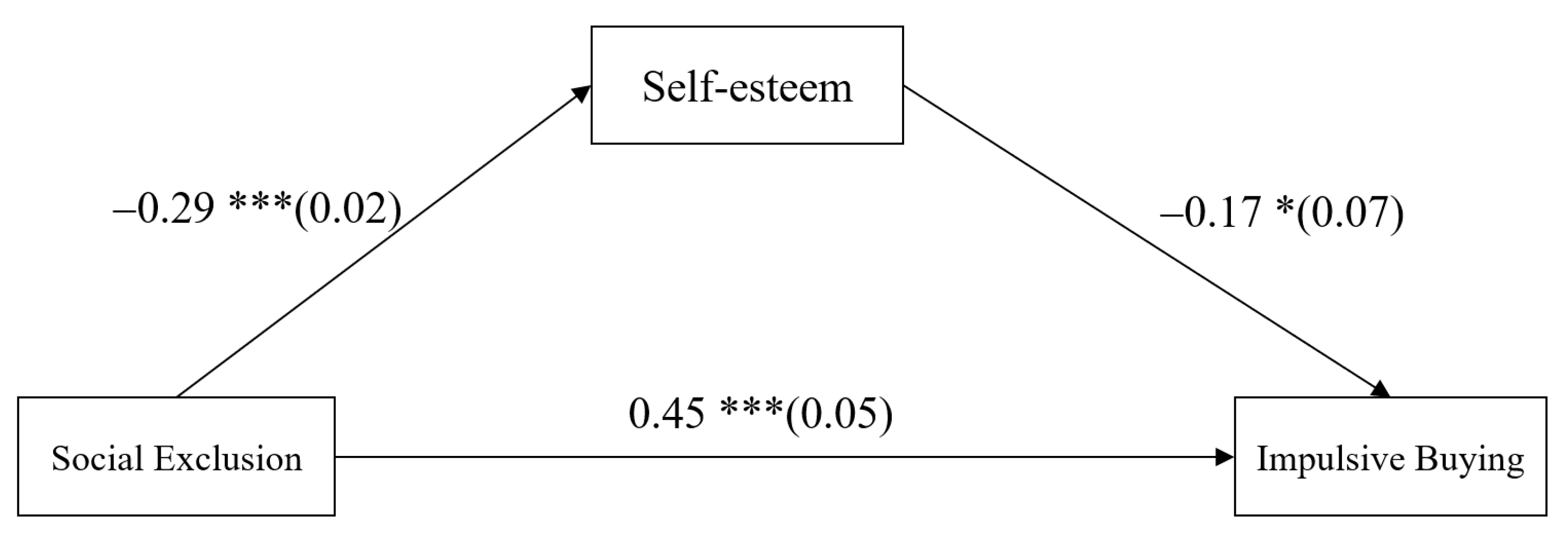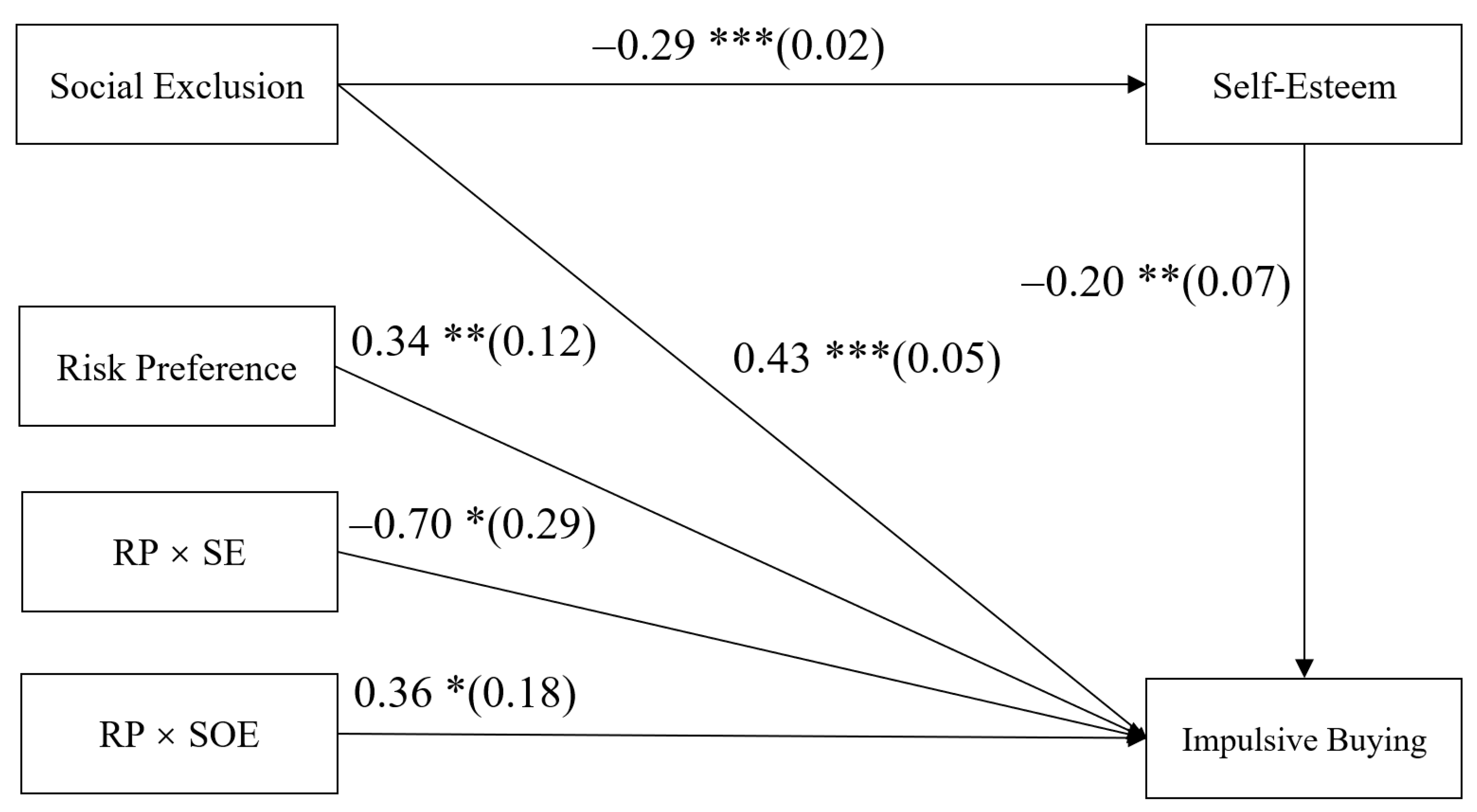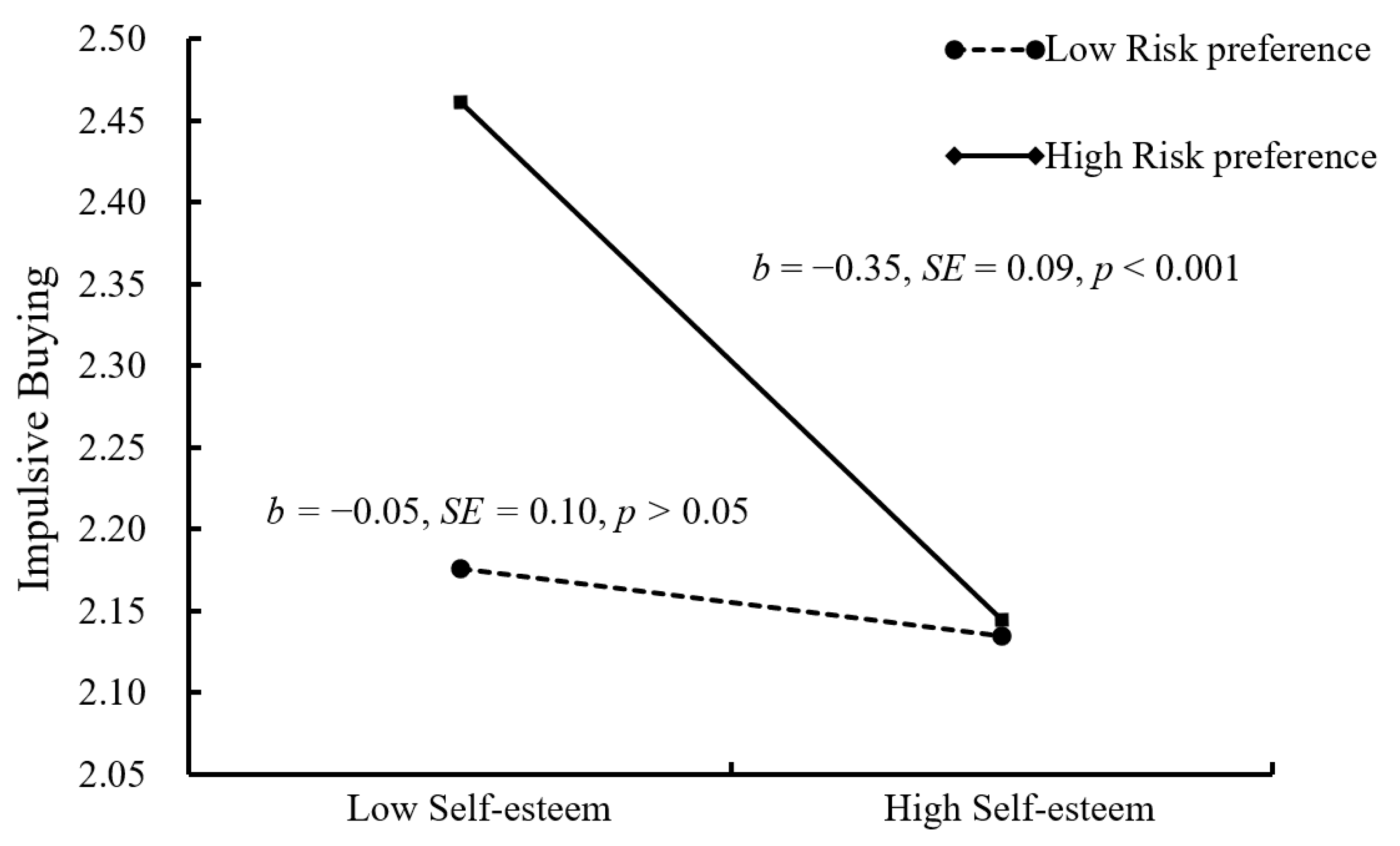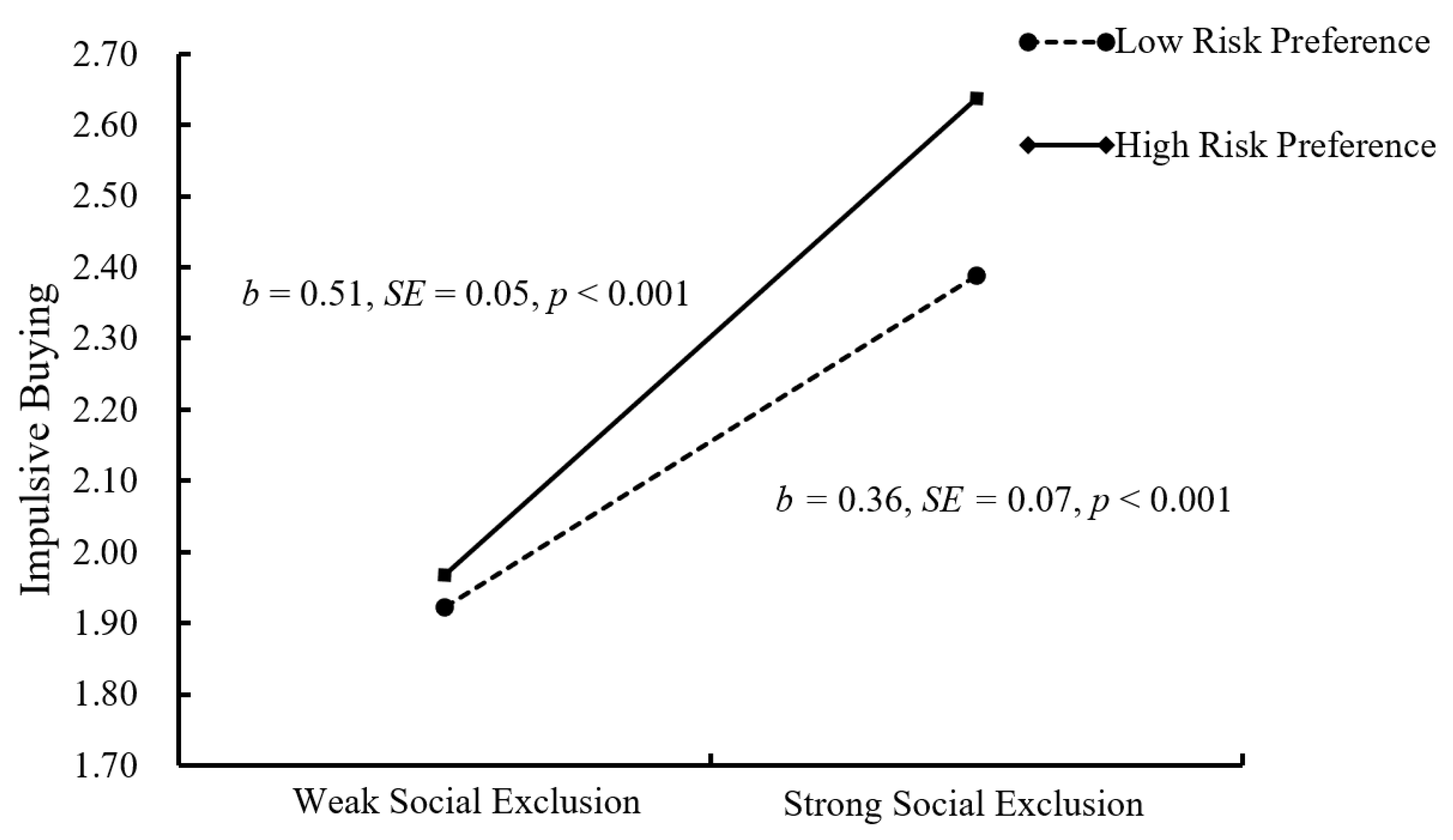Social Exclusion and Impulsive Buying among Chinese College Students: The Mediating Role of Self-Esteem and the Moderating Role of Risk Preference
Abstract
:1. Introduction
2. Literature Review
2.1. Social Exclusion and College Students’ Impulsive Buying
2.2. Self-Esteem as a Mediator
2.3. Risk Preference as a Moderator
3. Methods
3.1. Participants
3.2. Procedure
3.3. Measures
3.3.1. Social Exclusion
3.3.2. Self-Esteem
3.3.3. Risk Preference
3.3.4. Impulsive Buying
3.3.5. Control Variable
4. Results
4.1. Preliminary Analyses
4.2. Testing for Mediation Effects of Self-Esteem
4.3. Testing for Moderated Mediation
5. Discussion
5.1. The Relationship between Social Exclusion and Impulsive Buying
5.2. The Mediating Role of Self-Esteem
5.3. The Moderating Role of Risk Preference
5.4. Limitations and Implications
6. Conclusions
Author Contributions
Funding
Institutional Review Board Statement
Informed Consent Statement
Data Availability Statement
Acknowledgments
Conflicts of Interest
References
- China Internet Network Information Center. Statistical Report on Internet Development in China. 2020. Available online: https://zndsssp.dangbei.net/2021/20210203.pdf (accessed on 1 March 2021).
- Lin, C.; Chuang, S. The effect of individual differences on adolescents’ impulsive buying behavior. Adolescence 2005, 40, 551–558. [Google Scholar]
- Arslan, G.; Coşkun, M. Social exclusion, self-forgiveness, mindfulness, and internet addiction in college students: A moderated mediation approach. Int. J. Mental Health Addict. 2021. [Google Scholar] [CrossRef]
- Li, S.; Zhao, F.; Yu, G. Social exclusion and depression among college students: A moderated mediation model of psychological capital and implicit theories. Curr. Psychol. 2021, 40, 1144–1151. [Google Scholar] [CrossRef]
- Xiao, S.; Nicholson, M. A multidisciplinary cognitive behavioural framework of impulse buying: A systematic review of the literature. Int. J. Manag. Rev. 2013, 15, 333–356. [Google Scholar] [CrossRef]
- Chung, N.; Song, H.; Lee, H. Consumers’ impulsive buying behavior of restaurant products in social commerce. Int. J. Contemp. Hosp. Manag. 2017, 29, 709–731. [Google Scholar] [CrossRef]
- Beatty, S.; Ferrell, M. Impulse buying: Modeling its precursors. J. Retail. 1998, 74, 169–191. [Google Scholar] [CrossRef]
- Sengupta, J.; Zhou, R. Understanding impulsives’ choice behaviors: The motivational influences of regulatory focus. J. Mark. Res. 2007, 44, 297–308. [Google Scholar] [CrossRef] [Green Version]
- Rook, D. The buying impulse. J. Consum. Res. 1987, 14, 189–199. [Google Scholar] [CrossRef]
- Joireman, J.; Kees, J.; Sprott, D. Concern with immediate consequences magnifies the impact of compulsive buying tendencies on college students’ credit card debt. J. Consum. Aff. 2010, 43, 155–178. [Google Scholar] [CrossRef]
- Bronfenbrenner, U.; Ceci, S. Nature-nurture reconceptualized in developmental perspective: A bioecological model. Psychol. Rev. 1994, 101, 568–586. [Google Scholar] [CrossRef]
- Bronfenbrenner, U.; Morris, P. The ecology of developmental processes. In Handbook of Child Psychology: Theoretical Models of Human Development; John Wiley & Sons Inc.: Hoboken, NJ, USA, 1998; pp. 993–1028. [Google Scholar]
- Criss, M.; Houltberg, B.; Cui, L.; Bosler, C.; Morris, A.; Silk, J. Direct and indirect links between peer factors and adolescent adjustment difficulties. J. Appl. Dev. Psychol. 2016, 43, 83–90. [Google Scholar] [CrossRef] [PubMed] [Green Version]
- Leary, M. Responses to social exclusion: Social anxiety, jealousy, loneliness, depression, and low self-esteem. J. Soc. Clin. Psychol. 1990, 9, 221–229. [Google Scholar] [CrossRef]
- MacDonald, G.; Leary, M.R. Why does social exclusion hurt? The relationship between social and physical pain. Psychol. Bull. 2005, 131, 202–223. [Google Scholar] [CrossRef] [Green Version]
- Skarstein, S.; Helseth, S.; Kvarme, L. It hurts inside: A qualitative study investigating social exclusion and bullying among adolescents reporting frequent pain and high use of non-prescription analgesics. BMC Psychol. 2020, 8, 112. [Google Scholar] [CrossRef]
- Buelow, M.; Wirth, J. Decisions in the face of known risks: Ostracism increases risky decision making. J. Exp. Soc. Psychol. 2016, 69, 210–217. [Google Scholar] [CrossRef]
- Bacon, A.; Cranford, A.; Blumenthal, H. Effects of ostracism and sex on alcohol consumption in a clinical laboratory setting. Psychol. Addict. Behav. 2015, 29, 664–672. [Google Scholar] [CrossRef]
- Peake, S.J.; Dishion, T.J.; Stormshak, E.A.; Moore, W.E.; Pfeifer, J. Risk-taking and social exclusion in adolescence: Neural mechanisms underlying peer influences on decision-making. Neuroimage 2013, 82, 23–34. [Google Scholar] [CrossRef] [Green Version]
- Twenge, J.; Baumeister, R.; Tice, D.; Stucke, T. If you can’t join them, beat them: Effects of social exclusion on aggressive behavior. J. Pers. Soc. Psychol. 2002, 81, 1058–1069. [Google Scholar] [CrossRef]
- Sarah, M.; Arthur, K. Negative affect: The dark side of retailing. J. Bus. Res. 2003, 56, 553–559. [Google Scholar]
- Arslan, G. Mediating role of the self–esteem and resilience in the association between social exclusion and life satisfaction among adolescents. Pers. Individ. Differ. 2019, 151, 109514. [Google Scholar] [CrossRef]
- Stenseng, F.; Belsky, J.; Skalicka, V.; Wichstrøm, L. Social exclusion predicts impaired self-regulation: A 2-year longitudinal panel study including the transition from preschool to school. J. Pers. 2014, 83, 212–220. [Google Scholar] [CrossRef] [Green Version]
- Dou, K.; Nie, Y.; Wang, Y.; Li, J.; Shen, W. Ego depletion promotes impulsive decision: Evidences from behavioral and ERPs studies. Acta Psychol. Sin. 2014, 46, 1564–1579. [Google Scholar] [CrossRef]
- Baumeister, R.; Twenge, J.; Nuss, C. Effects of social exclusion on cognitive processes: Anticipated aloneness reduces intelligent thought. J. Pers. Soc. Psychol. 2002, 83, 817–827. [Google Scholar] [CrossRef]
- Leary, M.; Terdal, S.; Tambor, E.; Downs, D. Self-esteem as an interpersonal monitor: The sociometer hypothesis. J. Pers. Soc. Psychol. 1995, 68, 518–530. [Google Scholar] [CrossRef]
- Rosenberg, M. Society and the Adolescent Self-Image; Princeton University Press: Princeton, NJ, USA, 1965. [Google Scholar]
- Stewart, C.; Rogers, F.; Pilch, M.; Stewart, I.; Barnes-Holmes, Y.; Westermann, S. The effect of social exclusion on state paranoia and explicit and implicit self-esteem in a non-clinical sample. J. Behav. Ther. Exp. Psychiatry 2017, 57, 62–69. [Google Scholar] [CrossRef] [PubMed] [Green Version]
- Yang, J.; Xu, X.; Chen, Y.; Shi, Z.; Han, S. Trait self-esteem and neural activities related to self-evaluation and social feedback. Sci. Rep. 2016, 6, 20274. [Google Scholar] [CrossRef] [PubMed] [Green Version]
- Baumeister, R.F.; Campbell, J.; Krueger, J.; Vohs, K. Does high self-esteem cause better performance, interpersonal success, happiness, or healthier lifestyles? Psychol. Sci. Public Interest 2003, 4, 1–44. [Google Scholar] [CrossRef] [Green Version]
- Wang, P.; Zhao, M.; Wang, X.; Xie, X.; Wang, Y.; Lei, L. Peer relationship and adolescent smartphone addiction: The mediating role of self-esteem and the moderating role of the need to belong. J. Behav. Addict. 2017, 6, 256–263. [Google Scholar] [CrossRef] [PubMed]
- Bandyopadhyay, N. The role of self-esteem, negative affect and normative influence in impulse buying: A study from India. Mark. Intell. Plan. 2016, 34, 523–539. [Google Scholar] [CrossRef]
- Dittmar, H.; Beattie, J.; Friese, S. Objects, decision considerations and self-image in men’s and women’s impulse purchases. Acta Psychol. 1996, 93, 187–206. [Google Scholar] [CrossRef]
- Bayley, G.; Nancarrow, C. Impulse purchasing: A qualitative exploration of the phenomenon. Qual. Market Res. 1998, 1, 99–114. [Google Scholar] [CrossRef] [Green Version]
- Dhandra, T. Does self-esteem matter? A framework depicting role of self-esteem between dispositional mindfulness and impulsive buying. J. Retail. Consum. Serv. 2020, 55, 102135. [Google Scholar] [CrossRef]
- Hsee, C.K.; Weber, E. A fundamental prediction error: Self-others discrepancies in risk preference. J. Exp. Psychol.-Gen. 1997, 126, 45–53. [Google Scholar] [CrossRef]
- Liang, Z.; Xu, Y.; Jiang, J. The individual differences research in decision making. Adv. Psychol. Sci. 2007, 15, 689–694. [Google Scholar]
- Donohew, L.; Zimmerman, R.; Cupp, P.; Colon, S.; Abell, R. Sensation seeking, impulsive decision-making, and risky sex: Implication for risk-taking and design of interventions. Pers. Individ. Differ. 2000, 28, 1079–1091. [Google Scholar] [CrossRef]
- Robbins, R.; Bryan, A. Relationships between future orientation, impulsive sensation seeking, and risk behavior among adjudicated adolescents. J. Adolesc. Res. 2004, 19, 428–445. [Google Scholar] [CrossRef]
- Bechara, A.; Damasio, H.; Tranel, D.; Damasio, A. The Iowa Gambling Task and the somatic marker hypothesis. Trends Cogn. Sci. 2005, 9, 159–162. [Google Scholar] [CrossRef]
- Farley, K. Helium diffusion from apatite: General behavior as illustrated by Durango fluorapatite. J. Geophys. Res. 2000, 105, 2903–2914. [Google Scholar] [CrossRef] [Green Version]
- Litwin, G.H.; Stringer, R. Motivation and Organizational Climate; Harvard University Press: Boston, MA, USA, 1968. [Google Scholar]
- Wang, M.; Chen, Z.; Zhang, S.; Xu, T.; Zhang, R.; Suo, T.; Feng, T. High self-control reduces risk preference: The role of connectivity between right orbitofrontal cortex and right anterior cingulate cortex. Front. Neurosci. 2019, 13, 194. [Google Scholar] [CrossRef] [Green Version]
- Denson, T.; Pedersen, W.; Friese, M.; Hahm, A.; Roberts, L. Understanding impulsive aggression: Angry rumination and reduced self-control capacity are mechanisms underlying the provocation-aggression relationship. Pers. Soc. Psychol. Bull. 2011, 37, 850–862. [Google Scholar] [CrossRef] [Green Version]
- Muthén, L.K.; Muthén, B.O. Mplus User’s Guide, 1998–2012, 7th ed.; Muthén & Muthén: Los Angeles, CA, USA, 1998. [Google Scholar]
- Hoyle, R.H. Handbook of Structural Equation Modeling; Guilford Press: New York, NY, USA, 2012. [Google Scholar]
- Wu, H.; Zhang, S.; Zeng, Y. Development and validation of the social exclusion questionnaire for undergraduate. J. Health Psychol. 2013, 21, 1829–1831. [Google Scholar] [CrossRef]
- Jing, F.; Yue, H. A study on the impulsive buying tendency scale of Chinese consumers. Pub. Finan. Res. 2005, 5, 37–40. [Google Scholar] [CrossRef]
- Nassan, N.; Muhammad, A.; Syed, O.; Arshad, M. Impact of gender, education and age on impulsive buying: Moderating role of consumer emotional intelligence. Int. J. Transform. Oper. Mark. Manag. 2017, 1, 4–17. [Google Scholar]
- Rana, S.; Tirthani, J. Effect of education, income and gender on impulsive buying among Indian consumer an empirical study of readymade garment customers. Indian J. Appl. Res. 2011, 1, 145–146. [Google Scholar] [CrossRef]
- Petersen, N.; König, H.H.; Hajek, A. The link between falls, social isolation and loneliness: A systematic review. Arch. Gerontol. Geriatr. 2020, 88, 104020. [Google Scholar] [CrossRef] [PubMed]
- Mead, N.; Baumeister, R.; Stillman, T.; Rawn, C.; Vohs, K. Social exclusion causes people to spend and consume strategically in the service of affiliation. J. Consum. Res. 2011, 37, 902–919. [Google Scholar] [CrossRef] [Green Version]
- Wo, J.; Lin, C.; Ma, H.; Li, F. A study on the development characteristics of adolescents’ interpersonal relations. Psychol. Dev. Educ. 2001, 17, 9–15. [Google Scholar]
- Ingemarson, M.; Rosendahl, I.; Bodin, M.; Birgegård, A. Teacher’s use of praise, clarity of school rules and classroom climate: Comparing classroom compositions in terms of disruptive students. Soc. Psychol. Educ. 2020, 23, 217–232. [Google Scholar] [CrossRef]





| Variables | M | SD | 1 | 2 | 3 | 4 | 5 | 6 | 7 | 8 |
|---|---|---|---|---|---|---|---|---|---|---|
| 1. Gender | 0.50 | 0.50 | 1 | |||||||
| 2. Age | 20.25 | 1.52 | 0.01 | 1 | ||||||
| 3. Family monthly income | 2.00 | 0.78 | 0.02 | −0.01 | 1 | |||||
| 4. Monthly living expenses | 1.82 | 0.56 | −0.04 | −0.05 | 0.43 *** | 1 | ||||
| 5. Social exclusion | 1.83 | 0.65 | 0.04 | −0.07 | −0.16 *** | −0.08 * | 1 | |||
| 6. Impulsive buying | 3.00 | 0.85 | −0.12 *** | −0.02 | 0.06 | 0.19 *** | 0.36 *** | 1 | ||
| 7. Self-esteem | 2.74 | 0.46 | 0.02 | 0.07 * | 0.15 *** | 0.08 * | −0.43 *** | −0.22 *** | 1 | |
| 8. Risk preference | 0.41 | 0.22 | 0.03 | −0.03 | 0.04 | 0.07 | 0.04 | 0.12 *** | −0.03 | 1 |
Publisher’s Note: MDPI stays neutral with regard to jurisdictional claims in published maps and institutional affiliations. |
© 2021 by the authors. Licensee MDPI, Basel, Switzerland. This article is an open access article distributed under the terms and conditions of the Creative Commons Attribution (CC BY) license (https://creativecommons.org/licenses/by/4.0/).
Share and Cite
Luo, H.; Chen, J.; Li, S.; Nie, Y.; Wang, G. Social Exclusion and Impulsive Buying among Chinese College Students: The Mediating Role of Self-Esteem and the Moderating Role of Risk Preference. Int. J. Environ. Res. Public Health 2021, 18, 11027. https://doi.org/10.3390/ijerph182111027
Luo H, Chen J, Li S, Nie Y, Wang G. Social Exclusion and Impulsive Buying among Chinese College Students: The Mediating Role of Self-Esteem and the Moderating Role of Risk Preference. International Journal of Environmental Research and Public Health. 2021; 18(21):11027. https://doi.org/10.3390/ijerph182111027
Chicago/Turabian StyleLuo, Haocheng, Jiarong Chen, Shengnan Li, Yangang Nie, and Guodong Wang. 2021. "Social Exclusion and Impulsive Buying among Chinese College Students: The Mediating Role of Self-Esteem and the Moderating Role of Risk Preference" International Journal of Environmental Research and Public Health 18, no. 21: 11027. https://doi.org/10.3390/ijerph182111027
APA StyleLuo, H., Chen, J., Li, S., Nie, Y., & Wang, G. (2021). Social Exclusion and Impulsive Buying among Chinese College Students: The Mediating Role of Self-Esteem and the Moderating Role of Risk Preference. International Journal of Environmental Research and Public Health, 18(21), 11027. https://doi.org/10.3390/ijerph182111027






